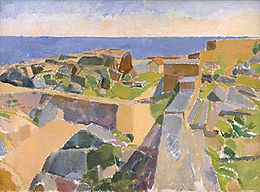Bornholm school of painters

Karl Isakson
The Bornholm school of painters started to take shape towards the beginning of the 20th century on the Danish island of Bornholm when a number of artists developed a distinctive style of classic modernism, inspired by the island's unique landscapes and light. Karl Isakson and Edvard Weie were among the first to paint the island's constantly changing natural beauty, using pure, subdued colour to produce work in new aesthetic directions. They were soon joined by other Danish artists including Niels Lergaard, Kræsten Iversen and Oluf Høst. They lived mainly in the picturesque little ports of Gudhjem and Svaneke on the northern coast, adventuring at times over to the small island of Christiansø where they found further seclusion and inspiration.[1]
Many of the works of the Bornholm School can be seen in the Bornholm Art Museum near Gudhjem and in the Oluf Høst Museum in Gudhjem itself.
See also
References
- ^ The Bornholm School from the Rough Guide to Denmark. Retrieved 10 December 2008.
